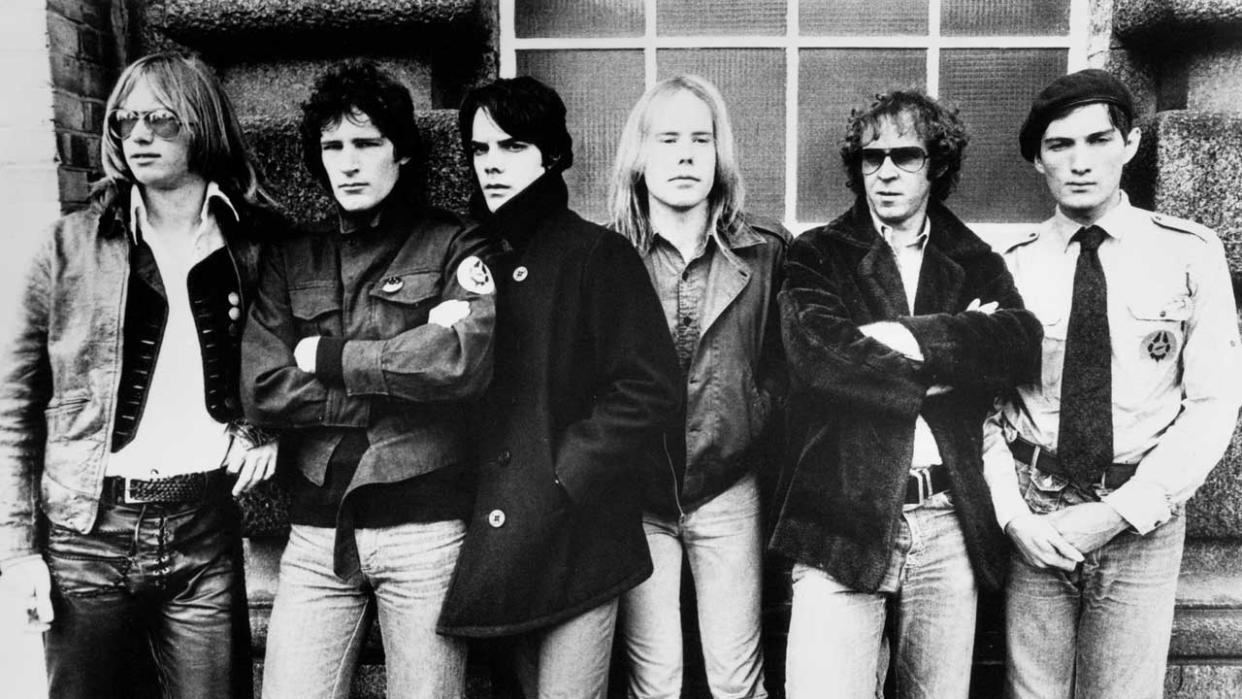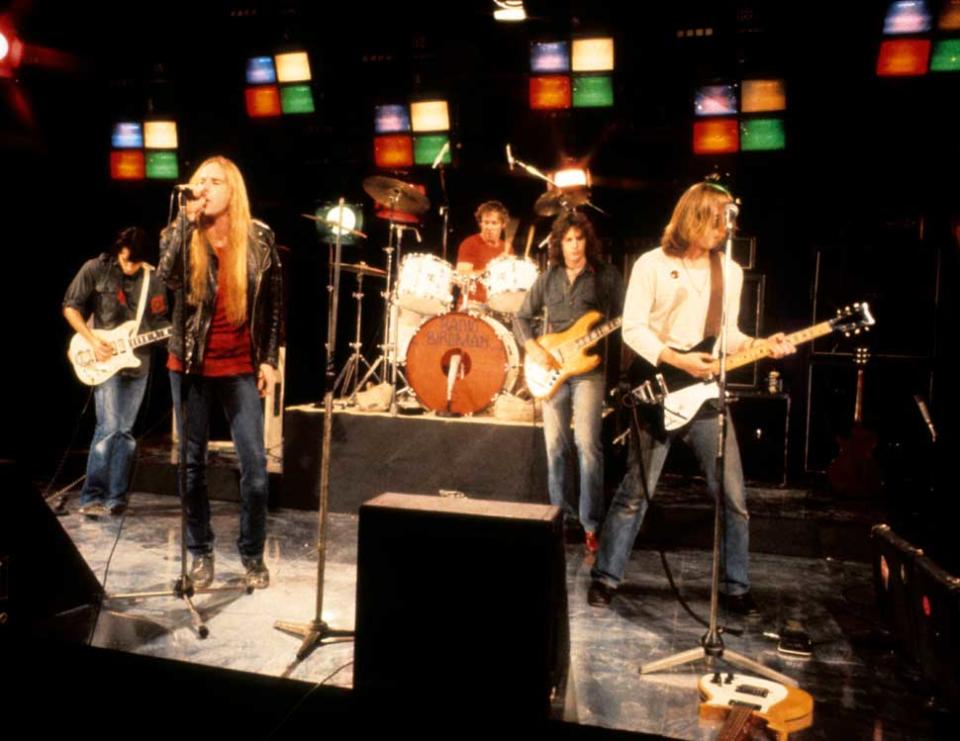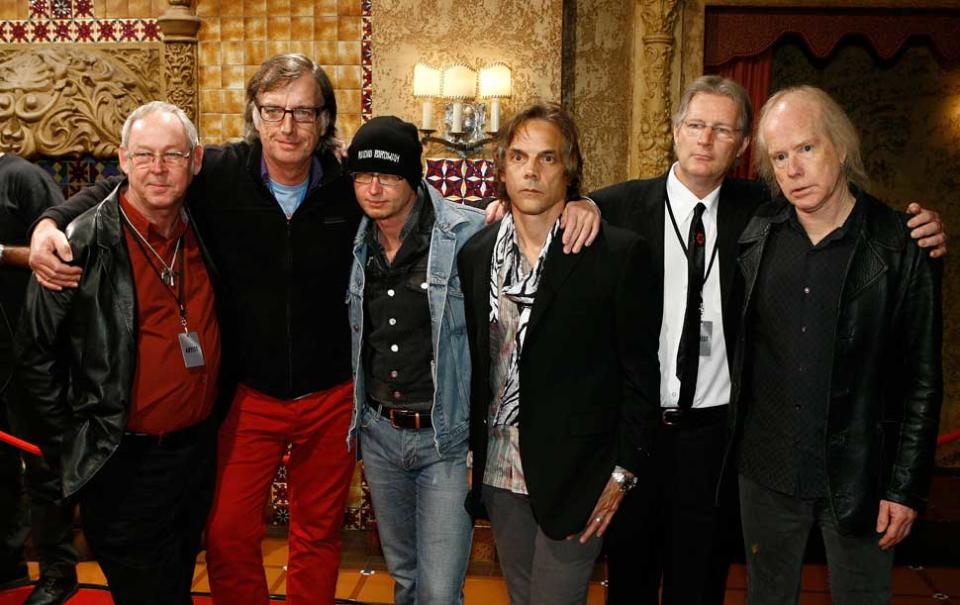"We had a real human skull. Its name was Govinda, and it used to sit on top of a mic stand at gigs, like a mascot" the story of Radio Birdman, the original Oz punks

It’s a Saturday night in the market town of Aylesbury, and a packed Friars club is celebrating its ninth birthday. Since it opened in 1969, the club has become renowned for its receptive crowds. It was here that David Bowie chose to unveil Ziggy Stardust, while more recently, it has embraced the punk revolution, presenting the likes of The Ramones, The Stranglers and Buzzcocks.
The second band on the bill tonight are from the other side of the world. Radio Birdman are Australia’s first and most influential punk band. The Sydney band’s debut album, Radios Appear, was released the previous year, and a track from it, Hand Of Law, appears on the influential Sire compilation The Sire Machine Turns You Up.
There’s no lack of interest or aggro in Aylesbury tonight as Birdman crank into action. Younger is a commanding presence, and next to him American-born guitarist Deniz Tek unleashes a merciless fret bliztkrieg. Their supernatural Stooges-MC5 attack contains strains of the Stones and surf music, even Blue ?yster Cult (from whose song Dominance And Submission they lifted the phrase ‘Radios Appear’) and The Doors, the latter courtesy of keyboard player Pip Hoyle. It’s a ferocious display.
Yet by the end of the year, Radio Birdman will be no more, crushed by the wheels of the music industry and those trend-dictated times. But their initial two-year incarnation would have a huge impact, especially in their home country. Today, they stand alongside The Easybeats, AC/DC and The Angels as one of the most important home-grown bands in the history of Australian rock
“The first song I learnt how to play on guitar was The Ventures’ Walk Don’t Run when I was 12,” says Tek today. “My guitar teacher was Dan Erlewine, who was playing in the Prime Movers at the time, with Iggy drumming.”
Tek began his career in his early teens, playing Kinks covers in basement bands. But it was the radical, high-energy rock’n’roll of fellow Michigan bands MC5 and especially The Stooges who truly turned his head. “The early Stooges were a revelation,” he says. “It was more performance art. They used to call the music ‘energy freak-outs’. Scotty [Asheton, Stooges drummer] was beating on oil drums with steel pipes.”
By 1972, Tek was growing increasingly tired of Detroit. He knew his time was up in the city when the band he was playing with threw him out. “I got home from school one day and saw my amp sitting out in the driveway, and the ass end of the van pulling away down the street.”
Five years earlier, in 1967, he’d visited Australia with his parents and fallen in love with it. Determined to make a break with Detroit, he signed up for a medical studies course at the University of New South Wales in Sydney.
“I arrived there on my own in 1972 with a guitar and backpack,” he recalls. “Detroit never recovered after the riots in 1968, and was pretty much on life support by then. The contrast was striking: Australia was young, growing, everything was cheap, plenty of jobs and hardly any crime.”
It might have been a paradise, but Tek noticed that the music scene was less than striking. “All the cool beat and psych groups of the 60s, such as the Loved Ones, the Masters Apprentices, the Missing Links, The Easybeats, the Purple Hearts and The Zoot were gone. It was all post-hippie stoned electric boogie music, or weird Celtic druid stuff.”
Devotees of high-energy rock’n’roll were rare in Sydney, though that didn’t stop Tek casting around for like-minded musicians. He’d already clicked with a fellow student, classically trained keyboard player Philip ‘Pip’ Hoyle, and he ended up in a band called TV Jones, who evolved from playing Bonzo Dog and oddball Beefheart songs into what the guitarist calls “a fairly anarchic blend of Alice Cooper, Velvets and The Stooges”. TV Jones bagged a residency in a pub in the mining town of Wollongong, but they faced a tougher challenge when it came to playing Sydney.
“When we tried to move into mainstream places, where the money was, we got violently rejected by venue owners and their hired bouncer thugs,” he says. “The band voted me out for interfering with their chances at commercial success.”
By 1974, Tek was living in a student house that would become Radio Birdman’s ground zero. It was there that he met drummer Ron Keeley, who introduced him to future Birdman singer Rob Younger. The latter pair had their own band, The Rats, who were playing the sort of music Tek loved. He and Younger became fast friends, each turning the other to new bands. By the time Tek was sacked from TV Jones, The Rats were also finished. Tek and Younger decided to start a new band, with Ron Keeley on drums, Tek’s college friend Pip Hoyle on keyboards and, eventually, bassist Warwick Gilbert and second guitarist Chris Masuak.

“We couldn’t play anywhere for the first year or so,” says Tek. “We’d get a gig, show up, and after the first two songs they would pull the power and throw us out. There were brawls, battles. Defend yourself with a mic stand and end up in the back of a police car. Always had something happening. Eventually we ran out of places that would book us, so we started running our own shows in rented halls and garages. Eventually we found a home at the Oxford.”
The Oxford Tavern was a bar on Sydney’s east side that would become Radio Birdman’s training ground. Their residency there came about as a result of some nifty hustling. When Lou Reed arrived at Sydney Airport for a show, the band were waiting for him with a Birdman T-shirt. On being presented with it, Reed expressed desire to catch the band live. Scrambling to arrange a gig that night, they persuaded the Oxford to let them play for nothing.
Lou didn’t show but the pub sold so much beer the group landed a regular night. After they took over managing the pub and renaming it the Oxford Funhouse (another Stooges reference), it became Ground Zero for the Sydney punk scene – the city’s equivalent of New York’s CBGB or The Roxy in London.
Radio Birdman’s own shows started getting even more extreme. “We were always on the lookout for some new way to freak people out,” says Tek. “Pip had a real human skull. Its name was Govinda, and used to sit on top of a mic stand at gigs, like a mascot. We got the idea of buying sheep brains at the butcher and putting them into Govinda’s cranium. We did that and Rob took it a step further by eating the raw brain and spitting it out off the front of the stage. The place cleared out in an instant. It seemed like a great idea at the time.”
Cold-shouldered by established record labels, Radio Birdman recorded their first EP, Burn My Eye, on a shoestring budget at Trafalgar Studio in the Sydney suburb of Annandale. The EP was released on the studio’s own label in October 1976 (around the same time as I’m Stranded, the career-launching single from fellow Oz punk pioneers The Saints). “I knew we were on the right track,” say Tek, “but that first EP sounds very tame compared to most of the later gear.”
With Tek writing the songs, Trafalgar financed and released the band’s debut album, Radios Appear. It was recorded piecemeal over several months throughout late 1976 and into early 1977.
“We were allowed into the studio only when there were no paying customers, so the band was playing a lot of shows and evolving the whole time. We’re dragging our equipment in and out of Trafalgar Studios, sometimes playing gigs on the same weekend as recording. We dragged in some sheets of corrugated iron from a nearby demolition site to harden the sound a bit.”
“Obviously we weren’t a punk band,” says Tek. “Rob had long hair. We didn’t like safety pins. We hated gobbing. Musically, we had six guys, relatively complex arrangements and improvised interacting solos. The hardcore Brit punks were more into a political fashion than anything to do with music. We were all about music. It didn’t mix well. We played The Vortex club on the last night of its existence. It ended with a vicious brawl with many injuries and punks hauled off to the casualty unit.”
They were also plagued by a degree of bad luck. Their European tour with the Flamin’ Groovies was curtailed after just two days when the latter’s guitarist Cyril Jordan slipped backstage and severed a tendon in his hand with the champagne bottle he was carrying. The later UK leg of the tour would take place, though not before Radio Birdman opened for Van Halen in Amsterdam.
Their bad luck wasn’t finished yet. After returning to the UK for gigs, the band began recording their second album, Living Eyes, at Rockfield Studios in Wales.
“We were sick, tired, broke and suffering from all kinds of personal and interpersonal problems,” says Tek. “I immersed myself in the work of making the album, and lost myself in the process. I was in denial, even though the band was coming apart at the seams. That was obvious to everyone. But we got it done. It was sequenced to have a light side and a dark side, just like the band itself.”

Their turbulent European experience was enough to be the final straw when they returned to Australia in late 1978. Deniz Tek, Ron Keeley and Pip Hoyle formed The Visitors, while Younger put together The Other Side. Tek had left Wales with a copy of the final mix of Radio Birdman’s ill-fated second album in his bag, and it was eventually released in Australia and New Zealand in 1981. It was more subtle than its predecessor, though it still dripped with Detroit-influenced energy. When they eventually came to promote the record, Tek went straight to the source.
“We knew we couldn’t restart Radio Birdman, so we did the next best thing and started a surrogate group called New Race, with Dennis Thompson of the MC5 on drums and Ron Asheton of The Stooges on guitar,” says Tek. “We toured Australia and released our own live album, The First And The Last, which I am very proud of.”
In the decades since their demise, Radio Birdman have reformed sporadically – even recording a third album, Zeno Beach, in 2006, while 2017 saw the release of Descent into the Maelstrom – The Radio Birdman Story, a feature-length documentary. They last performed live in 2019.
In 2014, after nearly four years work, Radio Birdman Box Set was released. Sourced from archived studio tapes, it featured both the original and Sire versions of Radios Appear, alongside Living Eyes and a recording of a semi-legendary show at Sydney’s Paddington Town Hall. It’s a fitting monument to an overlooked but vital part of rock’n'roll history.
“I hadn’t heard any of that stuff for a long time, and it’s stood the test of time for sure,” says Tek, who today runs a coffee farm on Hawaii. "We had something cool going on."
New vinyl editions of the Sire version of Radios Appear are available to pre-order from Citadel now. European customers can place orders at Arcade Sounds.
